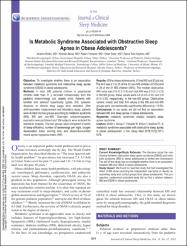| dc.contributor.author | Erdim, İbrahim | |
| dc.contributor.author | Akçay, Teoman | |
| dc.contributor.author | Yılmazer, Rasim | |
| dc.contributor.author | Erdur, Ömer | |
| dc.contributor.author | Kayhan, Fatma Tülin | |
| dc.date.accessioned | 10.07.201910:49:13 | |
| dc.date.accessioned | 2019-07-10T19:57:45Z | |
| dc.date.available | 10.07.201910:49:13 | |
| dc.date.available | 2019-07-10T19:57:45Z | |
| dc.date.issued | 2015 | en_US |
| dc.identifier.citation | Erdim, İ., Akçay, T., Yılmazer, R., Erdur, Ö. ve Kayhan, F. T. (2015). Is metabolic syndrome associated with obstructive sleep apnea in obese adolescents? Journal of Clinical Sleep Medicine, 11(12), 1371-1376. https://dx.doi.org/10.5664/jcsm.5266 | en_US |
| dc.identifier.issn | 1550-9389 | |
| dc.identifier.issn | 1550-9397 | |
| dc.identifier.uri | https://dx.doi.org/10.5664/jcsm.5266 | |
| dc.identifier.uri | https://hdl.handle.net/20.500.12511/3040 | |
| dc.description | WOS: 000367581700004 | en_US |
| dc.description | PubMed ID: 26156956 | en_US |
| dc.description.abstract | Objective: To investigate whether there is an association between metabolic syndrome and obstructive sleep apnea syndrome (OSAS) in obese adolescents. Methods: In total, 240 pubertal children or prepubertal children older than 11 y recruited consecutively from the pediatric endocrinology unit, obesity clinic. Patients with tonsillar and adenoid hypertrophy (grade 3/4), systemic illnesses, or chronic drug usage were excluded. After anthropometric measurement and laboratory study, patients were divided into two groups according to metabolic syndrome (MS): MS and non-MS. Overnight polysomnographic evaluation was performed and 104 subjects were included for statistical analysis. The two groups were compared in terms of sleep efficiency, number of awakenings per night, oxygen desaturation index, snoring time, and obstructive/central/mixed apnea-hypopnea index (AHI). Results: Of the obese adolescents, 51 had MS and 53 did not. The AHI was >= 1 in 25 of the 53 non-MS children (47.2%) and in 25 of the 51 MS children (49%). The median obstructive AHI value was 0.9 (0.2-2.4) and total AHI was 0.9 (0.2-2.5) in the MS group; these values were 0.9 (0.25-3.55) and 0.9 (0.3-3.55), respectively, in the non-MS group. Obstructive, central, mixed, and total AHI values in the MS and non-MS groups were not statistically significantly different (p > 0.05). Conclusions: In our study, we did not find an association between MS and sleep apnea in obese adolescents. | en_US |
| dc.language.iso | eng | en_US |
| dc.publisher | American Academy of Sleep Medicine | en_US |
| dc.rights | info:eu-repo/semantics/openAccess | en_US |
| dc.subject | Metabolic Syndrome | en_US |
| dc.subject | Obesity | en_US |
| dc.subject | Pediatric Sleep | en_US |
| dc.subject | Apnea Syndrome | en_US |
| dc.title | Is metabolic syndrome associated with obstructive sleep apnea in obese adolescents? | en_US |
| dc.type | article | en_US |
| dc.relation.ispartof | Journal of Clinical Sleep Medicine | en_US |
| dc.department | İstanbul Medipol Üniversitesi, Tıp Fakültesi, Cerrahi Tıp Bilimleri Bölümü, Kulak Burun Boğaz Hastalıkları Ana Bilim Dalı | en_US |
| dc.authorid | 0000-0002-2447-2446 | en_US |
| dc.identifier.volume | 11 | en_US |
| dc.identifier.issue | 12 | en_US |
| dc.identifier.startpage | 1371 | en_US |
| dc.identifier.endpage | 1376 | en_US |
| dc.relation.publicationcategory | Makale - Uluslararası Hakemli Dergi - Kurum Öğretim Elemanı | en_US |
| dc.identifier.doi | 10.5664/jcsm.5266 | en_US |
| dc.identifier.wosquality | Q2 | en_US |
| dc.identifier.scopusquality | Q1 | en_US |


















